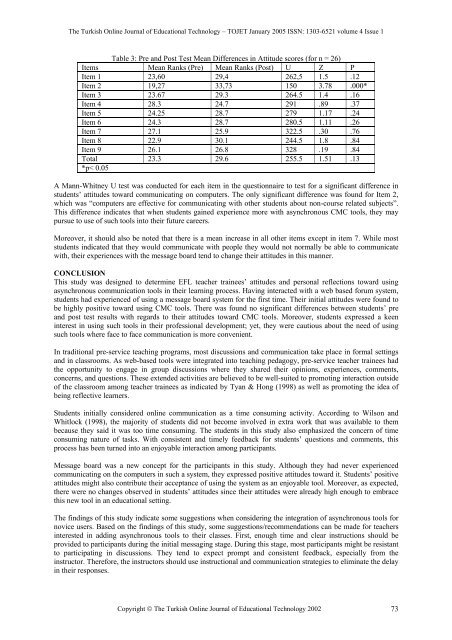Age - TOJET the Turkish online journal of educational technology
Age - TOJET the Turkish online journal of educational technology
Age - TOJET the Turkish online journal of educational technology
You also want an ePaper? Increase the reach of your titles
YUMPU automatically turns print PDFs into web optimized ePapers that Google loves.
The <strong>Turkish</strong> Online Journal <strong>of</strong> Educational Technology – <strong>TOJET</strong> January 2005 ISSN: 1303-6521 volume 4 Issue 1<br />
Table 3: Pre and Post Test Mean Differences in Attitude scores (for n = 26)<br />
Items Mean Ranks (Pre) Mean Ranks (Post) U Z P<br />
Item 1 23,60 29,4 262,5 1.5 .12<br />
Item 2 19,27 33,73 150 3.78 .000*<br />
Item 3 23.67 29.3 264.5 1.4 .16<br />
Item 4 28.3 24.7 291 .89 .37<br />
Item 5 24.25 28.7 279 1.17 .24<br />
Item 6 24.3 28.7 280.5 1.11 .26<br />
Item 7 27.1 25.9 322.5 .30 .76<br />
Item 8 22.9 30.1 244.5 1.8 .84<br />
Item 9 26.1 26.8 328 .19 .84<br />
Total 23.3 29.6 255.5 1.51 .13<br />
*p< 0.05<br />
A Mann-Whitney U test was conducted for each item in <strong>the</strong> questionnaire to test for a significant difference in<br />
students’ attitudes toward communicating on computers. The only significant difference was found for Item 2,<br />
which was “computers are effective for communicating with o<strong>the</strong>r students about non-course related subjects”.<br />
This difference indicates that when students gained experience more with asynchronous CMC tools, <strong>the</strong>y may<br />
pursue to use <strong>of</strong> such tools into <strong>the</strong>ir future careers.<br />
Moreover, it should also be noted that <strong>the</strong>re is a mean increase in all o<strong>the</strong>r items except in item 7. While most<br />
students indicated that <strong>the</strong>y would communicate with people <strong>the</strong>y would not normally be able to communicate<br />
with, <strong>the</strong>ir experiences with <strong>the</strong> message board tend to change <strong>the</strong>ir attitudes in this manner.<br />
CONCLUSION<br />
This study was designed to determine EFL teacher trainees’ attitudes and personal reflections toward using<br />
asynchronous communication tools in <strong>the</strong>ir learning process. Having interacted with a web based forum system,<br />
students had experienced <strong>of</strong> using a message board system for <strong>the</strong> first time. Their initial attitudes were found to<br />
be highly positive toward using CMC tools. There was found no significant differences between students’ pre<br />
and post test results with regards to <strong>the</strong>ir attitudes toward CMC tools. Moreover, students expressed a keen<br />
interest in using such tools in <strong>the</strong>ir pr<strong>of</strong>essional development; yet, <strong>the</strong>y were cautious about <strong>the</strong> need <strong>of</strong> using<br />
such tools where face to face communication is more convenient.<br />
In traditional pre-service teaching programs, most discussions and communication take place in formal settings<br />
and in classrooms. As web-based tools were integrated into teaching pedagogy, pre-service teacher trainees had<br />
<strong>the</strong> opportunity to engage in group discussions where <strong>the</strong>y shared <strong>the</strong>ir opinions, experiences, comments,<br />
concerns, and questions. These extended activities are believed to be well-suited to promoting interaction outside<br />
<strong>of</strong> <strong>the</strong> classroom among teacher trainees as indicated by Tyan & Hong (1998) as well as promoting <strong>the</strong> idea <strong>of</strong><br />
being reflective learners.<br />
Students initially considered <strong>online</strong> communication as a time consuming activity. According to Wilson and<br />
Whitlock (1998), <strong>the</strong> majority <strong>of</strong> students did not become involved in extra work that was available to <strong>the</strong>m<br />
because <strong>the</strong>y said it was too time consuming. The students in this study also emphasized <strong>the</strong> concern <strong>of</strong> time<br />
consuming nature <strong>of</strong> tasks. With consistent and timely feedback for students’ questions and comments, this<br />
process has been turned into an enjoyable interaction among participants.<br />
Message board was a new concept for <strong>the</strong> participants in this study. Although <strong>the</strong>y had never experienced<br />
communicating on <strong>the</strong> computers in such a system, <strong>the</strong>y expressed positive attitudes toward it. Students’ positive<br />
attitudes might also contribute <strong>the</strong>ir acceptance <strong>of</strong> using <strong>the</strong> system as an enjoyable tool. Moreover, as expected,<br />
<strong>the</strong>re were no changes observed in students’ attitudes since <strong>the</strong>ir attitudes were already high enough to embrace<br />
this new tool in an <strong>educational</strong> setting.<br />
The findings <strong>of</strong> this study indicate some suggestions when considering <strong>the</strong> integration <strong>of</strong> asynchronous tools for<br />
novice users. Based on <strong>the</strong> findings <strong>of</strong> this study, some suggestions/recommendations can be made for teachers<br />
interested in adding asynchronous tools to <strong>the</strong>ir classes. First, enough time and clear instructions should be<br />
provided to participants during <strong>the</strong> initial messaging stage. During this stage, most participants might be resistant<br />
to participating in discussions. They tend to expect prompt and consistent feedback, especially from <strong>the</strong><br />
instructor. Therefore, <strong>the</strong> instructors should use instructional and communication strategies to eliminate <strong>the</strong> delay<br />
in <strong>the</strong>ir responses.<br />
Copyright © The <strong>Turkish</strong> Online Journal <strong>of</strong> Educational Technology 2002 73
















